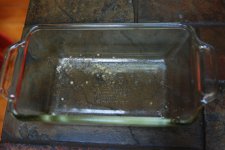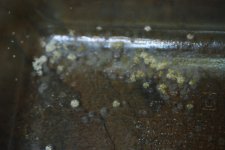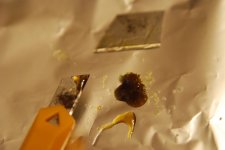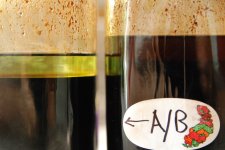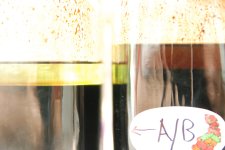UPDATE:
STB
I freeze precipped Pulls 4 & 5 (pics below). After pouring off the naptha and letting the residual naptha/moisture evaporate under a fan for 7 hours, the crystals looked goopy and yellower than any I have ever seen!! I scraped them up - a few stayed crystalline, but most became a resinous goop that adhered to the razors... I don't even know how to weigh this guck without losing half to the weighing tray! Are all STBs this dirty? Is it because the naptha is heated? if so, why would it not have happened to pulls 1,2 & 3? Can I even re-x this stuff cleanly? Sounds like I have a lot of additional work in store before I can even weigh my yield...:shock:
"A/B"
Pulled the first naptha layer and placed aside. It was surprisingly yellow (again, perhaps the heating?) I added more naptha for a second pull, heated as per the tek. 12 hours later, there was a slight emulsion... curious, no emulsion on the first pull, but yelowish naptha, and now a fine emulsion between the layers... I added 2 teaspoons of Lye (one per jar) and am waiting to see...
I'll keep you all posted. Any input greatly appreciated. I am trying to be thorough and meticulous with the methodology, but still have meagre extraction experience.
thanks, JBArk
STB
I freeze precipped Pulls 4 & 5 (pics below). After pouring off the naptha and letting the residual naptha/moisture evaporate under a fan for 7 hours, the crystals looked goopy and yellower than any I have ever seen!! I scraped them up - a few stayed crystalline, but most became a resinous goop that adhered to the razors... I don't even know how to weigh this guck without losing half to the weighing tray! Are all STBs this dirty? Is it because the naptha is heated? if so, why would it not have happened to pulls 1,2 & 3? Can I even re-x this stuff cleanly? Sounds like I have a lot of additional work in store before I can even weigh my yield...:shock:
"A/B"
Pulled the first naptha layer and placed aside. It was surprisingly yellow (again, perhaps the heating?) I added more naptha for a second pull, heated as per the tek. 12 hours later, there was a slight emulsion... curious, no emulsion on the first pull, but yelowish naptha, and now a fine emulsion between the layers... I added 2 teaspoons of Lye (one per jar) and am waiting to see...
I'll keep you all posted. Any input greatly appreciated. I am trying to be thorough and meticulous with the methodology, but still have meagre extraction experience.
thanks, JBArk

